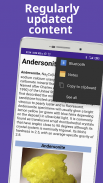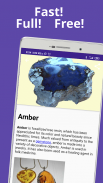










Minerals guide
Geology

Minerals guide: Geology의 설명
큰 백과사전 "광물 안내서: 지질학 툴킷"은 가장 중요한 용어와 개념을 다루는 완전한 무료 용어집입니다. 이를 통해 지질 학자와 애호가는 광물, 암석, 보석 및 수정 기능을 조사하고 탐색할 수 있습니다.
광물학은 화학, 결정 구조, 광물 및 광물화된 유물의 물리적 특성에 대한 과학적 연구를 전문으로 하는 지질학의 한 과목입니다. 광물학 내의 특정 연구에는 광물의 기원 및 형성 과정, 광물의 분류, 지리적 분포 및 활용이 포함됩니다.
광물을 식별하는 초기 단계는 물리적 특성을 조사하는 것이며, 그 중 다수는 손 샘플에서 측정할 수 있습니다. 이들은 밀도(종종 비중으로 표시됨)로 분류될 수 있습니다. 기계적 응집력 측정(경도, 인성, 분열, 파단, 분할); 거시적 시각적 특성(광택, 색상, 줄무늬, 발광, 투명도); 자기 및 전기적 특성; 염화수소의 방사능 및 용해도
결정 또는 결정질 고체는 구성 요소(예: 원자, 분자 또는 이온)가 고도로 정렬된 미세 구조로 배열되어 모든 방향으로 확장되는 결정 격자를 형성하는 고체 물질입니다. 또한 거시적 단결정은 일반적으로 특정 방향의 편평한 면으로 구성된 기하학적 모양으로 식별할 수 있습니다. 결정 및 결정 형성에 대한 과학적 연구는 결정학으로 알려져 있습니다. 결정 성장 메커니즘을 통한 결정 형성 과정을 결정화 또는 응고라고 합니다.
결정학은 결정질 고체의 원자 배열을 결정하는 실험 과학입니다. 결정학은 재료 과학 및 고체 물리학(응축 물질 물리학) 분야의 기본 과목입니다. 결정학에서 결정 구조는 결정질 물질에서 원자, 이온 또는 분자의 정렬된 배열에 대한 설명입니다. 정돈된 구조는 물질의 3차원 공간의 기본 방향을 따라 반복되는 대칭 패턴을 형성하기 위해 구성 입자의 고유한 특성에서 발생합니다.
몇몇 광물은 황, 구리, 은, 금을 포함한 화학 원소이지만 대부분은 화합물입니다. 성분을 식별하는 고전적인 방법은 산에 미네랄을 용해시키는 습식 화학 분석입니다.
미네랄로이드는 결정성을 나타내지 않는 자연 발생 광물 유사 물질입니다. 미네랄로이드는 특정 미네랄에 대해 일반적으로 허용되는 범위를 넘어서는 다양한 화학 조성을 가지고 있습니다.
보석(보석, 보석, 귀석 또는 준귀석이라고도 함)은 보석이나 기타 장신구를 만드는 데 사용되는 잘리고 연마된 형태의 수정 조각입니다. 대부분의 보석은 단단하지만 일부 부드러운 광물은 광택이나 미적 가치가 있는 기타 물리적 특성 때문에 보석에 사용됩니다. 희소성은 원석에 가치를 부여하는 또 다른 특성입니다.
금은 기호 Au(라틴어 aurum '금'에서 유래)와 원자 번호 79를 가진 화학 원소입니다. 이것은 자연적으로 발생하는 원자 번호가 더 높은 원소 중 하나입니다. 순수한 형태의 밝은, 약간 주황색-노란색의 조밀하고 부드러우며 가단성 및 연성 금속입니다.
약 4000개의 서로 다른 돌이 있으며 각각 고유한 물리적 특성을 가지고 있습니다. 여기에는 색상, 줄무늬, 경도, 광택, 투명도, 비중, 벽개, 균열, 자성, 용해도 등이 포함됩니다.
이 사전은 오프라인에서 무료로 제공됩니다:
• 자동 완성 기능이 있는 고급 검색 기능;
• 음성 검색;
• 오프라인 작업 - 앱과 함께 패키지된 데이터베이스, 검색 시 발생하는 데이터 비용 없음;
• 정의를 설명하기 위해 수백 가지 예를 포함합니다.
"미네랄 가이드"는 필요한 정보를 가까이에 두는 가장 좋은 방법입니다.




























